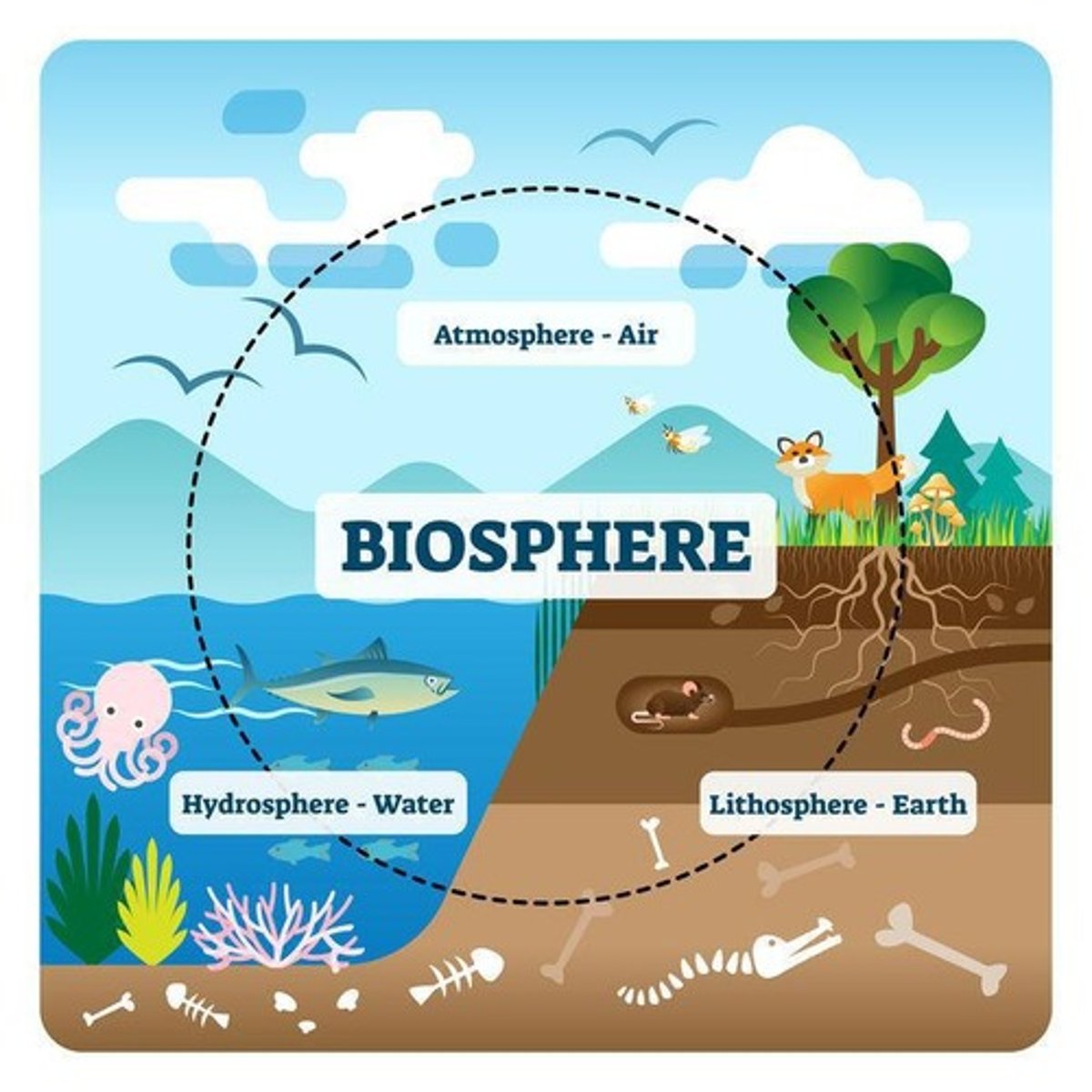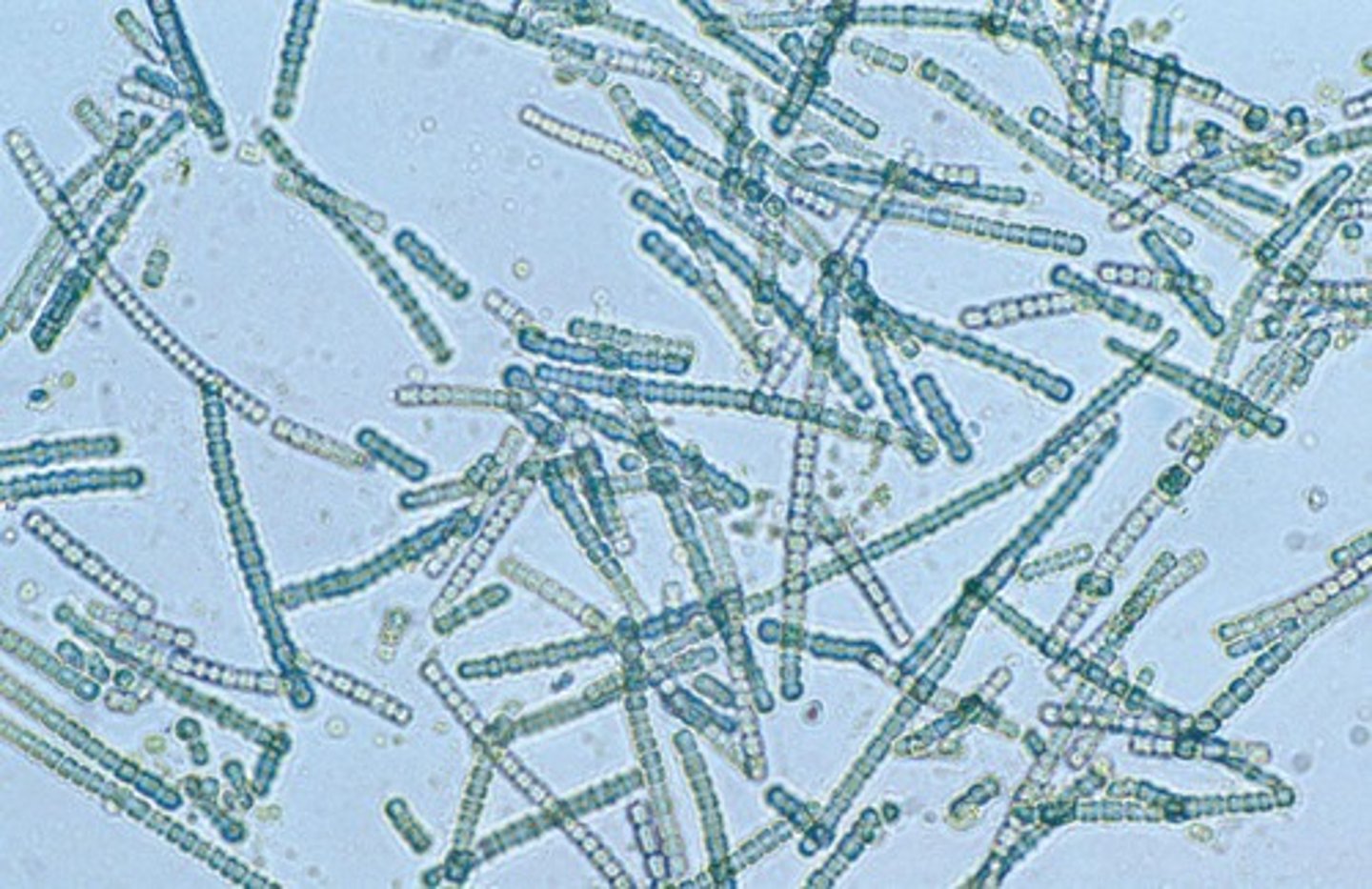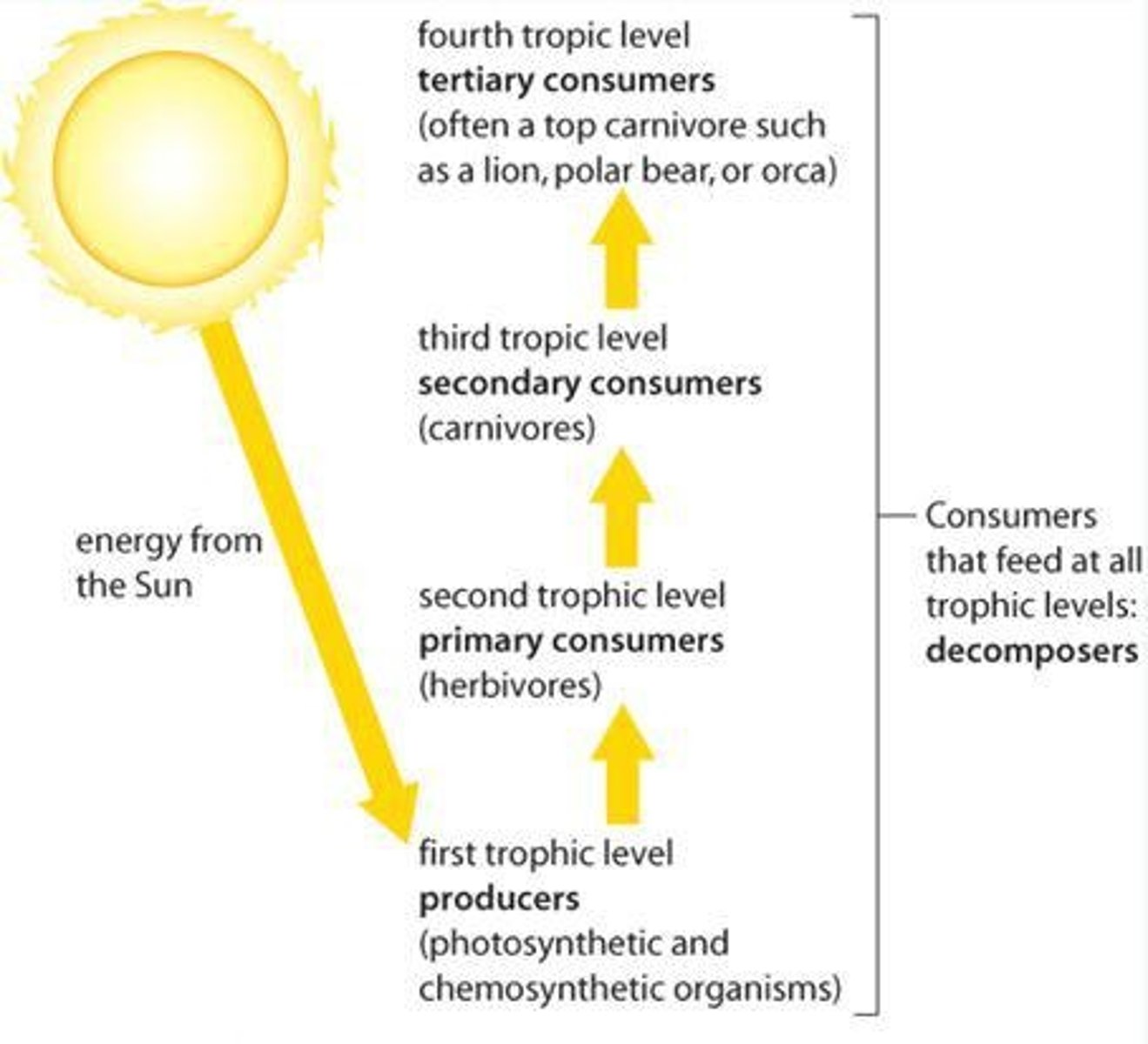Understanding the Biosphere and Energy Transfer
1/90
There's no tags or description
Looks like no tags are added yet.
Name | Mastery | Learn | Test | Matching | Spaced |
|---|
No study sessions yet.
91 Terms
Biosphere
All areas of earth that are inhabited by and support life - consists of atmosphere, lithosphere, and hydrosphere.

Hydrosphere
All of the water, SOLID and LIQUID, that exists in the lithosphere.
Lithosphere
Solid, mainly rocky part of earth, also called the geosphere.
Atmosphere
Gaseous part of earth, composed of: 21% oxygen, 78% nitrogen, 0.934% argon, and 0.036 other gases.
Isolated System
Matter and energy are not exchanged.
Closed System
Energy is exchanged but matter is not.
Open System
Energy and matter are exchanged between the system and its surroundings.
Energy Transfer - Radiation
Transmission through electromagnetic waves; reflected or absorbed by particles of matter.
Energy Transfer - Conduction
Transfer of thermal energy through direct contact between the particles of a substance, without moving the particles to a new location.
Energy Transfer - Convection
Transfer of thermal energy through the movement of particles from one location to another, usually occurs in fluids.
Solar Energy
Majority of the energy on earth originates from the sun.
One Way Flow of Energy
Solar energy and chemical energy harnessed by producers moves through the living components of the biosphere in a series of energy transfers.
1st Law of Thermodynamics
Energy can neither be created nor be destroyed, it can only be transferred from one form to another.
2nd Law of Thermodynamics
The entropy of any isolated system always increases.
Entropy
A measure of disorder or randomness in a system.
Kinetic Energy Increase
If the radiation is absorbed by matter, the kinetic energy of the particles will increase resulting in a temperature increase.
Energy Loss
Some energy is 'lost' (entropy) as heat with each energy transfer that takes place.
Thermal Energy Radiation
Thermal energy eventually radiates back out into space.
Incoming Solar Radiation
Some incoming solar radiation is reflected back into space by components of the atmosphere, lithosphere, and hydrosphere.
Photosynthesis
A very small amount of incoming solar radiation is absorbed by plants for use in photosynthesis.
Photosynthesis
Process by which photosynthetic organisms (PHOTOAUTOTROPHS) convert SOLAR ENERGY into CHEMICAL POTENTIAL ENERGY.
First oxygenic photoautotrophs
Cyanobacteria, responsible for the first oxygenation of the atmosphere - around 2.5 billion years ago.

Chemosynthesis
Is the process in which some organisms, called CHEMOAUTOTROPHS, split inorganic molecules, such as H2S(g), to release energy used to convert carbon-containing compounds, such as CH4(g) or CO2(g) into carbohydrates.
Chemoautotrophs
Microorganisms that live in hostile environmental conditions and do not require sunlight as an initial energy source.
Nitrogen-fixing bacteria
Chemoautotrophs that live in the soil.
Iron oxidizing bacteria
Chemoautotrophs that live in lava beds.
Sulfur oxidizing bacteria
Chemoautotrophs that live inside of tubeworms near deep sea hydrothermal vents, forming a symbiotic relationship.
Cellular Respiration
Process in which organisms react glucose with oxygen to produce carbon dioxide, water, and energy.
ATP
The usable form of energy for cells.
Energy-storing processes
Processes that balance out energy in ecosystems.
Energy-releasing processes
Processes that balance out energy in ecosystems.
Producers
Also called autotrophs, includes photoautotrophs and chemoautotrophs, forming the base of all food chains/webs.
Consumers
Also called heterotrophs, meaning they consume autotrophs or other heterotrophs as a food source.
Primary Consumers
Consume producers directly—e.g., insects, snails, grazing mammals, and some fish.
Secondary Consumers
Consume mainly primary consumers (herbivores)—e.g., spiders, frogs, and some birds.
Tertiary Consumers
Consume mainly secondary consumers—e.g., snakes, giant crabs, and sharks.
Quaternary Consumers
Consume mainly tertiary consumers—e.g., wolves and whales.
Decomposers
Organisms that consume detritus (dead organic matter and waste), important for recycling inorganic matter so it is available to autotrophs.
Examples of decomposers
Bacteria and fungi.
Trophic Levels
A feeding level in an ecosystem at which matter and energy are transferred.
First Trophic Level
Consists of producers.
Second Trophic Level
Consists of primary consumers.
Third Trophic Level
Consists of secondary consumers.
Fourth Trophic Level
Consists of tertiary consumers.
Fifth Trophic Level
consists of quaternary consumers
Trophic Levels
There is always less energy available at higher trophic levels - thus there are fewer organisms at higher levels, also limiting the number of trophic levels
Energy Transfer
~ 10% of energy available at one trophic level is transferred to the next trophic level
Abiotic Factors
The number of trophic levels is also limited by the availability of abiotic factors such as sunlight, water, and inorganic nutrients.
Food Chain
A food chain is a model that shows the linear pathways through which energy is transferred through the trophic levels.

Food Web
A food web is a model of energy transfer that shows the connections among food chains.
Ecosystem Stability
Increased food web complexity/larger numbers of energy transfers results in increased ecosystem stability.
Pyramid of Numbers
Type of ecological pyramid that represents the relative numbers of organisms at each trophic level.
Pyramid of Biomass
Type of ecological pyramid that represents the amount of biomass—dry mass of living or once-living organisms per unit area—at each trophic level.
Pyramid of Energy
Type of ecological pyramid that represents the amount of energy at each trophic level.

Biogeochemical Cycles
Pathway by which chemical substance moves through the biotic and the abiotic compartments of Earth.
Recycling of Matter
The recycling of matter through the biotic and abiotic components of the ecosystem allows all organisms to obtain essential nutrients.
Nutrient Reservoirs
At each step in a biogeochemical cycle, substances are temporarily stored in nutrient reservoirs, such as organisms, air, soil, and water.
Rapid Cycling of Nutrients
The rapid cycling of nutrients is when substances cycle between nutrient reservoirs relatively quickly—e.g., the movement of carbon from producer, to consumer, to decomposer.
Slow Cycling of Nutrients
The slow cycling of nutrients is when substances accumulate and are unavailable to organisms for a long period of time—e.g., fossil fuels, peat, and rocks.
Role of Water in Biogeochemical Cycles
Water is essential to all known living organisms.
Nutrient Transport
All living cells require water for transport of nutrients and biochemical reactions.
Photosynthesis
Photoautotrophs need water for photosynthesis.
Role of Water in Biogeochemical Cycles
Water is a polar molecule and consists of 2 hydrogen atoms bonded covalently to an oxygen atom.
Polarity of Water
The polarity results in hydrogen bonding between water molecules, giving water its unique properties.
Carbon and Oxygen Cycle
The carbon and oxygen cycles are closely linked through the processes of photosynthesis and cellular respiration.
Rapid Cycling of Carbon
The rapid cycling of carbon involves photosynthesis, cellular respiration, decomposition, combustion, dissolving of CO2 in water, and evaporation of CO2 from water.
Slow Cycling of Carbon
The slow cycling of carbon involves the formation of fossil fuels, formation of rocks, formation of sediments in the deep ocean, and weathering.
Carbon Sinks
The ocean is the largest carbon sink - water absorbs CO2 and producers use CO2.
Photosynthetic Producers
Photosynthetic producers use CO2 in photosynthesis.
Effects of Deforestation
Deforestation and rising ocean temperatures result in increased atmospheric CO2 levels.
Carbon Sources
Burning of fossil fuels releases CO2.
Cellular Respiration
Cellular respiration produces CO2.
Natural Carbon Sources
Forest fires and volcanoes (natural carbon sources) release CO2.
Limestone Weathering
Limestone (CaCO3) formed from shells of aquatic organisms or precipitation in water weathers over time, releasing carbon back into the soil, air, and water.
Nitrogen as Essential
Nitrogen is a component of ATP, proteins, and genetic material (DNA).
Atmospheric Nitrogen
Our atmosphere is 78% nitrogen, but organisms cannot use it.
Usable Nitrogen Forms
Most plants can only use the nitrate ion (NO3+) or the nitrite ion (NO2-).
Ammonium Ion Usage
Some plants can use the ammonium ion (NH4-).
Nitrogen Fixation
Nitrogen fixation is the process by which some bacteria convert nitrogen gas (N2(g)) into ammonium ions (NH4+).
Ammonification
Ammonification is a process by which decomposers break down organic matter into ammonium ions (NH4+).
Nitrification
Nitrification is a process by which nitrifying soil bacteria convert the ammonium ion (NH4+) into nitrite (NO2-).
Lightning's Role in Nitrogen Cycle
Lightning can also convert atmospheric nitrogen into nitrate ions.
Denitrification
Denitrification is a process by which anaerobic denitrifying bacteria convert nitrate (NO3-) or nitrite (NO2-) back into nitrogen gas (N2(g)).
Phosphorus Importance
Phosphorus is essential for DNA, ATP, bones, cell membranes, and teeth.
Usable Phosphorus Form
Producers can only use phosphorus if it is in the form of a phosphate ion (PO4^3-).
Rapid Cycling of Phosphorus
The rapid cycling of phosphorus involves uptake of phosphorus by plants, consumption of plants and animals, and decomposition.
Slow Cycling of Phosphorus
The slow cycling of phosphorus involves formation of sediment, geological uplifting, and weathering from rocks.
Biological Productivity
Biological productivity is the rate at which an ecosystem's producers capture and store energy within organic compounds over a certain length of time (g/m2/a).
Factors Affecting Biological Productivity
Biological productivity depends on the number of producers, the amount of light and heat available, time of year, available nutrients, and the amount of rainfall a system receives.
Biosphere Equilibrium
Equilibrium between photosynthesis and cellular respiration influences atmospheric composition of carbon dioxide and oxygen.
The Gaia Hypothesis
The Gaia Hypothesis, proposed by ecologist James Lovelock in 1979, suggests the biosphere acts like an organism that regulates itself, maintaining environmental conditions within certain limits, referred to as dynamic equilibrium.